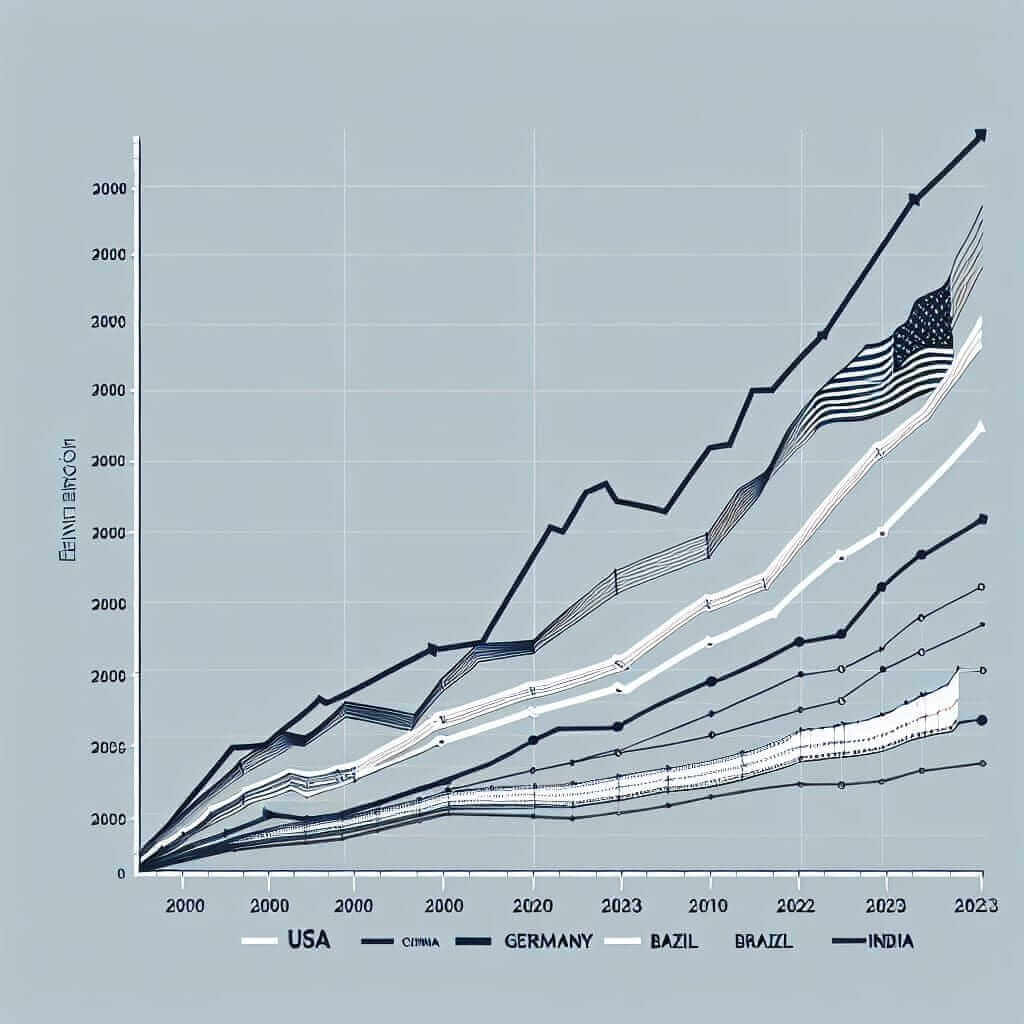Renewable energy has become a central topic in the global discourse on sustainable development and climate change. For IELTS candidates, understanding trends in renewable energy production can provide a significant advantage, particularly in Writing Task 1. This task often involves interpreting and describing data, such as those related to energy production.
Introduction
When focusing on “Trends in Renewable Energy Production (2000-2023)” for your IELTS Writing Task 1, you should be prepared to describe data trends accurately and coherently. Let’s begin by presenting some potential prompts you might encounter in the exam.
Example Prompts:
- “The graphs below show the production of renewable energy in five different countries from 2000 to 2023. Summarize the information by selecting and reporting the main features, and make comparisons where relevant.”
- “The chart illustrates the change in renewable energy production in Europe between 2000 and 2023. Summarize the data by highlighting key trends and making relevant comparisons.”
- “The table below presents the data on renewable energy generation in Asia from 2000 to 2023. Summarize the main trends and compare the production across different years.”
Analyzing a Sample Task
We will choose the first prompt for detailed analysis and writing practice.
Sample Data:
Assume we have the following data for the sample prompt:
Graph of Renewable Energy Production in Five Countries (2000-2023)
| Year | USA | Germany | China | India | Brazil |
|---|---|---|---|---|---|
| 2000 | 50 | 30 | 20 | 10 | 40 |
| 2005 | 70 | 50 | 40 | 20 | 45 |
| 2010 | 90 | 70 | 60 | 35 | 60 |
| 2015 | 120 | 100 | 90 | 60 | 80 |
| 2020 | 150 | 140 | 130 | 100 | 120 |
| 2023 | 180 | 160 | 170 | 130 | 150 |

Analyzing the Data:
-
Identify Overall Trends:
- All five countries have shown a steady increase in renewable energy production from 2000 to 2023.
- The USA and China exhibit the highest production levels by 2023, while India starts as the lowest in 2000 but shows significant growth over the years.
-
Key Features:
- The USA started at 50 units in 2000 and escalated to 180 units by 2023, indicating a consistent rise.
- China witnessed the most dramatic increase, from 20 units in 2000 to 170 units in 2023.
- Germany and Brazil also show substantial growth, albeit at a slower pace compared to the USA and China.
-
Comparisons:
- In 2000, the USA produced more renewable energy than any other country, but by 2023, China’s production nearly matched that of the USA.
- Renewable energy production in India, although starting low, quadrupled by 2023, reflecting a significant growth trajectory.
Writing the Sample Response
Let’s draft a response in accordance with IELTS Writing Task 1 requirements.
Sample Response:
The line graph illustrates the production of renewable energy in five countries, namely the USA, Germany, China, India, and Brazil, from 2000 to 2023.
Overall, all five countries demonstrate a continuous increase in renewable energy production over the given period. Notably, the USA and China exhibit the highest levels of production, with significant growth particularly evident in China.
In 2000, the USA had the highest production rate of renewable energy at 50 units, followed by Brazil at 40 units and Germany at 30 units. India, producing just 10 units, lagged behind the other countries. Over the subsequent years, all countries increased their production, with the USA and China showing marked rises. By 2005, renewable energy production in China had doubled to 40 units, while the USA reached 70 units.
The trend continued robustly through to 2015, by which time the USA hit 120 units and China climbed to 90 units. Germany also saw its production grow to 100 units, while both India and Brazil experienced steady increases, reaching 60 and 80 units respectively.
By 2023, China’s renewable energy production surged to 170 units, nearly matching the USA which led at 180 units. Germany, Brazil, and India reached 160, 150, and 130 units, respectively. Despite India’s lower starting point, it demonstrated notable progress over the 23-year period.
In conclusion, while all countries have significantly ramped up their production of renewable energy, the USA and China have shown the most pronounced increases, reflecting broader global trends in renewable energy adoption and investment.
Word count: 232 words
Useful Vocabulary and Grammar for Writing Task 1
Vocabulary:
- Escalate (v) /ˈɛskəleɪt/: Increase rapidly.
- Substantial (adj) /səbˈstanʃəl/: Considerable in importance.
- Trajectory (n) /trəˈdʒɛktəri/: The path followed by an object or trend.
- Notably (adv) /ˈnəʊtəblɪ/: Worthy of attention.
- Surge (v) /sɜːdʒ/: A sudden powerful forward or upward movement.
Grammar:
- Comparative Structures: To compare data effectively (e.g., “more than”, “less than”, “the highest”, “the lowest”).
- Past Simple and Present Perfect: To indicate past data and ongoing trends (e.g., “produced” vs. “have shown”).
Tips for Success:
- Summarize Key Trends: Focus on overall trends rather than minute details.
- Make Comparisons: Highlight significant differences and similarities.
- Use Linking Words: Enhance coherence with words like “Furthermore,” “However,” and “In conclusion.”
- Practice Data Interpretation: Familiarize yourself with various data presentation formats.
Conclusion
To excel in IELTS Writing Task 1, understanding how to describe and compare trends in data, such as renewable energy production from 2000 to 2023, is crucial. Use the vocabulary and grammar tips provided, practice regularly, and ensure to focus on the main trends and key features. With dedication and practice, you can aim for a Band 7+ score.